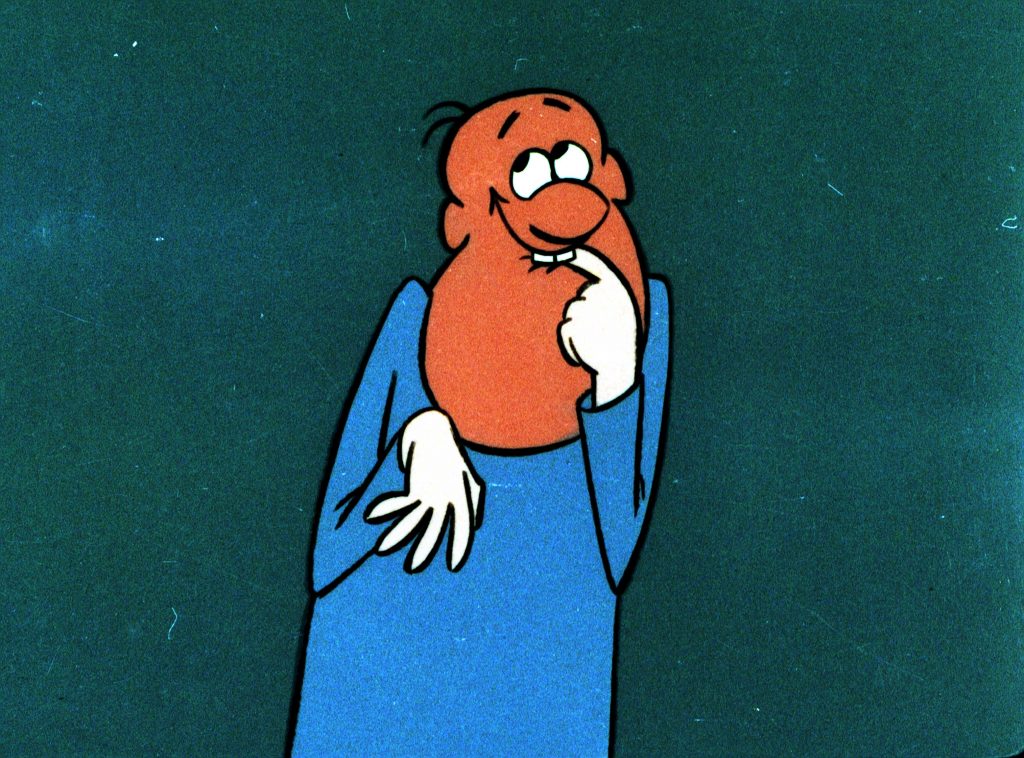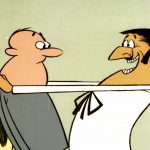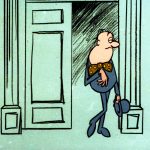Milen Alempijević
HOW TO PAINLESSLY PAINT THE WORLD IN BLACK
Notes on a (anti)hero
The Hungarian cultural public recently said their last good-bye to Marcell Jankovics (1941-2021), animated films director whose half a century long carrer has yielded some two hundred titles, including short films, TV commercials and series, as well as feature films. The eminent animation historian Giannalberto Bendazzi claims that from the very first steps made in the Pannonia Film in 1960s, Jankovics was one of the most prominent authors in this Budapest studio. His animated short Sisyphus from 1974 was nominated for the American Academy of Film Arts award, whereas his another short, The Struggle, won the Golden Palm award at Canes in 1977. Jankovics is the author of the first Hungarian animated feature film, Johnny Corncob (János vitéz, 1973), made in commemoration of 150 years of birth of the great Hungarian poet Sándor Petőfi. A dedicated researcher of history, folklore studies and mythology, his opus of animated feature films retains its attraction for cinephiles in works such as The White Mare’s Son (Fehérlófia, 1981) based on a Hungarian folk tale, or the historic drama Man’s Tragedy (Az ember tragédiáj, 2011) which took him almost three decades to accomplish, unwaveringly determined to pursue his original idea.
The importance of the opus of this classical author of the Hungarian and European animation was the reason why John Halas included him among the animation masters in his book of the same title. There can be no doubt that authors love public recognition, especially the ones that come from within one’s own profession, however, it is much rarer that an animated character becomes so recognised or at least recognisable that the audiences of different generations easily link it to it creator, over a long period of time. And the story of Jankovics and an animated character began only a few years after the nineteen-year old lad joined the Pannonia Film studio, with a reputation of a comic art lover who made his first attempts at comics inspired by stories of Ray Bradbury and Oscar Wilde. His first engagement at the studio was as a inbetweener at the studio’s ongoing projects, moving on quickly to start the collaboration with film directors and screen writers, renowned humourists Attila Dargay (1927-2009) and József Nepp (1934-2017). The thee of them are the ‘culprits’ for the birth of the most famous (anti)hero of the Hungarian animation – Gustavus (Gusztáv).
At the time when the Gustavus series was broadcast on Yugoslav television, the author of this text was an elementary-school pupil, happily overwhelmed by whatever Walt Disney and Warner Brothers craft manufacturing product would come by. However, there was a special place for Gustavus, too. A large head with only two hairs on it, a large nose, coupled with the proverbially unobtrusive grey suit and a bowler hat, he was light years away from the charismatic hero; still, his secret was not in his virtues, but rather in the flaws of an ordinary little fellow. The burlesque series provided a space where the authors could ridicule the eternal human imperfections, embodied in its protagonist, fittingly described by the animation historian Anna Ida Orosz as selfish, infantile, indifferent, comfortable average citizen, a clumsy sucker, an overzealous little man. Orosz reminds us of the several internal legendary accounts of how the main protagonist of the series got his name. The initial variations for the name were Ferenc, Dodó, Otto and Princ. According to one of the stories, Attila Dargay named the hero Gustavus after the clown, the Silly August. There is another version, which tells that Dargay randomly picked the name form a telephone directory. It is, however, most likely that Gustavus got his name after Gusztáv Ilosvay (1911-1961), musician, actor and composer. Considering Ilosvay’s taste for jazz music, it is perhaps no coincidence that the Gustavus series features a recognisable jazzy score, whose authors is the trumpet player Tomasz Deak, frontman of the Deak Big Band from 1964 and one of the pioneers of jazz education in Hungary.
Having started in 1964, the series lasted until 1979. Over this period, its context changed, and so did the hero’s physical appearance and the habitus. During 1960s, the episodes were intended for cinema screening, and the focus was on individual flaws and misgivings of the main character; however, with the shift to TV audiences during 1970s, the episodes increasingly adopt Hungary’s social reality as the setting, so that its satirical aspect becomes more pronounced as well. Not only is it apparent that Gustavus’ personal profile is a volatile one, but his social or family status are vague as well, to the point that we do not even know his occupation (a treatment that prompted the screenwriter József Nepp to call Gustavus ‘an experimental rabbit’, so that each episode describes a scene or an event that focuses on a character trait (a flaw) of the hero. For example, in the Gustavus at the Supermarket (Gusztav az ABC-ben) episode, suggestive advertisements lead Gustavus to buy piles of useless stuff, until eventually the frantic shopaholic ends up in hospital, where we see him running wildly pushing the wheel bed and hurling patients onto it, as if on a supermarket cart. In another episode, Gustavus is Getting Married (Gusztáv házasodni készül), our hero is finding flaws in every prospective match: whereas one is a smoker, another one does not care for football, and the Miss Universe does not favour vegetarian food. After feeding a list of wishes into a computer, Gustavus receives his perfect match: a picture of himself. In the Gustavus’ Inferiority Complex (Gusztáv komplexusa) episode, he is servile to everyone and gets out of everyone’s way, imagining himself as a worm that everybody wants to trample. Eventually, the psychiatrist gives him special glasses, so that everyone he sees through them appears naked. While Gustavus finds this funny, the world soon becomes a better place, since there are more and more people wearing glasses like his. This pun on humankind where everybody is at the same time a servant and an ‘emperor in new clothes’ leads us to the famous Gustavus is Daubing (Gusztáv mázol) episode shown in 1977, when the great animated adventure was drawing to its close. So, we see him using a brush dipped into black paint to mend a shabby monogram on a cuff button, but then a droplet of black paint ends up on the desk surface, so he decides to paint the desk as well. Recklessly leaving smears behind, Gustavus goes on to paint the lamp, the armchair, the walls and the ceiling, as well as the suit he is wearing. Next he goes out to buy more paint and gets down to work: soon the whole city will disappear in black… Gustavus, the uncrowned king of the absurd, worthy of Becket’s (anti)heroes! The reality as we know it is stepping back, making way for the new one. But why bother to imitate reality, as Jankovics observed in one of his interviews, when animation is a stylised fantastic world in itself. After seeing his Sisyphus, his mother told him: ‘Son, you will never make another film as good as this one.’ Yes, there are metaphors that last forever… Let us ask ourselves if Gustavus may be a grotesque version of Sisyphus, more than ever before reminding us of how our everyday reality has become a tiring affair with apparently no end in sight and an overwhelming feeling that we have not moved from square one? But let’s put a smile on our face, because if the Silly August is holding a brush, the world as we know it is, luckily, nearing its end. Vége.
Originally published in Serbian in Politika on June 12th 2021
Pictures by courtesy of Hungarian Film Institute




